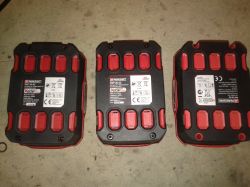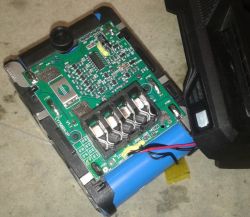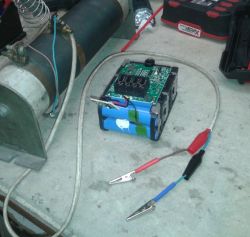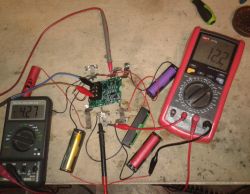Hello . I recently bought two devices from this company, both from the black Performance series. Impact hammer and angle grinder PWSAP 20-Li B2. Both were supplied with the same type of PAP 20 A3 battery.
I can recommend the grinder itself as well as the original Parkside discs, which I bought separately in a box for which there is space in the suitcase. Recently, the body has a fairly thick tube and the shield has lost almost nothing and the battery has only partially discharged.

The problem was with this battery. The next time I used it, it stopped relatively shortly after. I check the charge and zero (as I mentioned, after the previous cut, it was over half of the state ...) I installed the batteries from the hammer and finished the work. Some time later, I put this battery into the charger and it signals an error - both LEDs are blinking. It is obvious that the battery has died. I called Lidl and they gave me the number to the external service that deals with it. OWIM company. German number but service in Polish. After providing my personal data, the type of equipment and the date of purchase, you said that I would be informed by e-mail about how the complaint would be considered and, if approved, a new battery would be sent to me and the old one should be disposed of.
Interestingly, they did not ask for the serial number of the device or the scan of the receipt
If I receive a new battery and they do not request the return of the old one, I will of course include its detailed research here.
Today, being on the exchange, I bought a new such battery at a bargain price (a spare one will always come in handy, and if I manage to repair the old one and receive a new one, I will have four ...)
I read the instructions for the new battery and it says that only the PLG 20 A2 charger should be used for charging.
And here is the fundamental question from the subject, because the hammer was joined by the PLG 20 A3 charger
and for the PLG 20 A1 grinder. Chargers for the same batteries are identical in appearance but have different markings. The parameters of the latter two are also supposedly identical. Which one to use for charging?
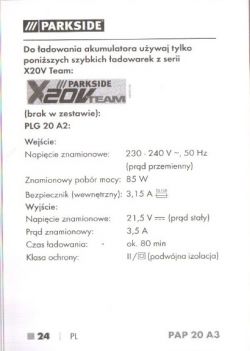
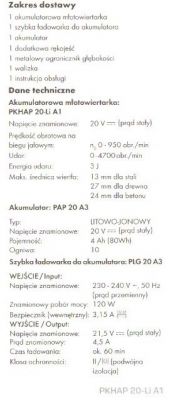
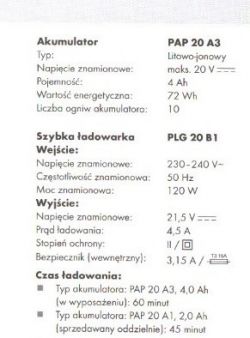
I also found a page with tests of cells used in these batteries Link
when I took a closer look, it looks like the chargers I have are from different manufacturers ...
One from Kompernass, the other from Omi. Likewise the batteries.
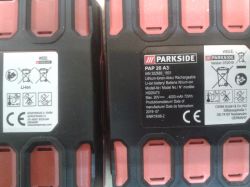
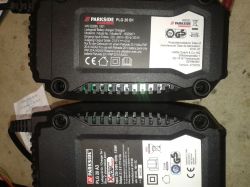
Hmm ...
Looks like I've already answered myself ...
Added after 1 [hours] 53 [minutes]:
But since the batteries have the same designation, it does not matter which I will charge. On the other hand, it is always better to use devices from one company ...
I can recommend the grinder itself as well as the original Parkside discs, which I bought separately in a box for which there is space in the suitcase. Recently, the body has a fairly thick tube and the shield has lost almost nothing and the battery has only partially discharged.

The problem was with this battery. The next time I used it, it stopped relatively shortly after. I check the charge and zero (as I mentioned, after the previous cut, it was over half of the state ...) I installed the batteries from the hammer and finished the work. Some time later, I put this battery into the charger and it signals an error - both LEDs are blinking. It is obvious that the battery has died. I called Lidl and they gave me the number to the external service that deals with it. OWIM company. German number but service in Polish. After providing my personal data, the type of equipment and the date of purchase, you said that I would be informed by e-mail about how the complaint would be considered and, if approved, a new battery would be sent to me and the old one should be disposed of.
Interestingly, they did not ask for the serial number of the device or the scan of the receipt

If I receive a new battery and they do not request the return of the old one, I will of course include its detailed research here.
Today, being on the exchange, I bought a new such battery at a bargain price (a spare one will always come in handy, and if I manage to repair the old one and receive a new one, I will have four ...)
I read the instructions for the new battery and it says that only the PLG 20 A2 charger should be used for charging.
And here is the fundamental question from the subject, because the hammer was joined by the PLG 20 A3 charger
and for the PLG 20 A1 grinder. Chargers for the same batteries are identical in appearance but have different markings. The parameters of the latter two are also supposedly identical. Which one to use for charging?



I also found a page with tests of cells used in these batteries Link
when I took a closer look, it looks like the chargers I have are from different manufacturers ...
One from Kompernass, the other from Omi. Likewise the batteries.


Hmm ...
Looks like I've already answered myself ...
Quote:Which one to use for charging?
Added after 1 [hours] 53 [minutes]:
But since the batteries have the same designation, it does not matter which I will charge. On the other hand, it is always better to use devices from one company ...



